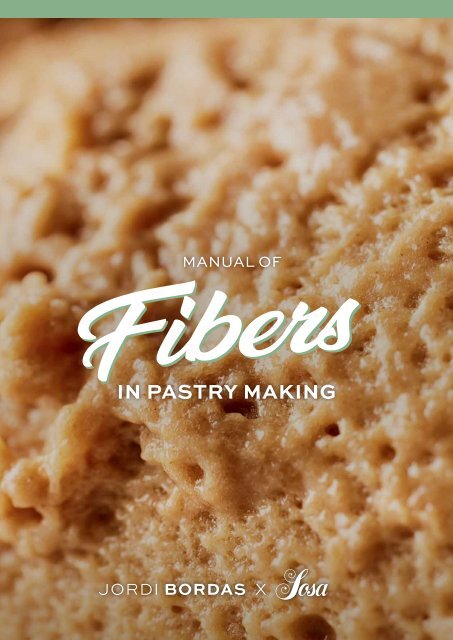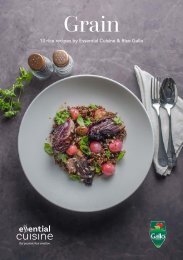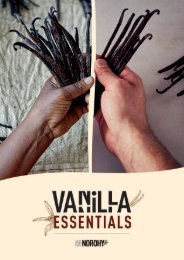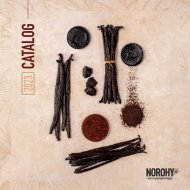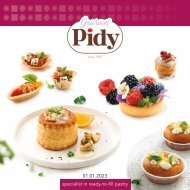You also want an ePaper? Increase the reach of your titles
YUMPU automatically turns print PDFs into web optimized ePapers that Google loves.
MANUAL OF<br />
Fibers<br />
IN PASTRY MAKING<br />
JORDI BORDAS X
Editorial<br />
Gastronomy is chang<strong>in</strong>g, consumers have new demands:<br />
they are look<strong>in</strong>g to reduce sugars and fats <strong>in</strong> their diets,<br />
reduce or elim<strong>in</strong>ate animal prote<strong>in</strong>s, take care <strong>of</strong> their impact<br />
on the environment. And with this transformation, <strong>pastry</strong><br />
pr<strong>of</strong>essionals are fac<strong>in</strong>g new technical challenges.<br />
At Sosa Ingredients we work every day to provide <strong>in</strong>gredients<br />
and <strong>in</strong>novative solutions to the technical challenges <strong>of</strong><br />
gastronomy pr<strong>of</strong>essionals. This is how we have detected a new<br />
fiber with <strong>in</strong>terest<strong>in</strong>g functionalities: Flaxfiber.<br />
Flaxfiber confirms that <strong>fibers</strong> are here to stay, and that they<br />
represent a new play<strong>in</strong>g field <strong>in</strong> gastronomy.<br />
In our efforts to cont<strong>in</strong>ue contribut<strong>in</strong>g to gastronomy with new<br />
<strong>in</strong>gredients, we have worked <strong>in</strong> alliance with Jordi Bordas, one<br />
<strong>of</strong> the pioneer<strong>in</strong>g centres <strong>in</strong> R+D+I <strong>in</strong> <strong>pastry</strong>, and one <strong>of</strong> the<br />
first to explore the use <strong>of</strong> <strong>fibers</strong>.<br />
Dur<strong>in</strong>g the last year, both teams have worked hard to<br />
demonstrate that the <strong>in</strong>corporation <strong>of</strong> fiber <strong>in</strong> recipes improves<br />
textures, allows to reduce sugars and fats and, at the same<br />
time, improves the flavour <strong>of</strong> the products. This is how this<br />
manual on the use <strong>of</strong> <strong>fibers</strong> <strong>in</strong> <strong>pastry</strong> was born, which we hope<br />
will serve as a guide to reformulate your proposal from now on.<br />
About JORDI BORDAS<br />
After w<strong>in</strong>n<strong>in</strong>g the Coupe du Monde<br />
de Pâtisserie <strong>in</strong> 2011, Jordi Bordas<br />
founded the <strong>pastry</strong> school <strong>in</strong> Viladecans<br />
(Barcelona) with the aim <strong>of</strong> transmitt<strong>in</strong>g<br />
all his experience and knowledge to the<br />
new generations <strong>of</strong> the sweet sector.<br />
With the B-Concept, Jordi revolutionised<br />
the world <strong>of</strong> <strong>pastry</strong> by demonstrat<strong>in</strong>g that<br />
a healthier, lighter, and tastier <strong>pastry</strong> is<br />
not only possible, but that it is one <strong>of</strong> the<br />
ma<strong>in</strong> needs <strong>of</strong> consumers.<br />
About<br />
Sosa Ingredients is one <strong>of</strong> the<br />
lead<strong>in</strong>g manufacturers and<br />
suppliers <strong>of</strong> top-quality <strong>in</strong>gredients<br />
for bakery and gastronomy.<br />
Founded <strong>in</strong> Catalonia <strong>in</strong> 1967.<br />
Sosa Ingredients is committed<br />
to us<strong>in</strong>g its technological knowhow<br />
to <strong>in</strong>novate and improve its<br />
products constantly to make a<br />
more responsible and accessible<br />
gastronomy.
Structure<br />
FIBERS IN PASTRY<br />
THE KEY INGREDIENT OF<br />
TOMORROW’S PASTRY<br />
5<br />
Collaboration Sosa <strong>in</strong>gredients & Jordi Bordas:<br />
a natural collaboration around Fibers ...................... 6<br />
<strong>SOSA</strong> FIBERS AND THEIR<br />
CATEGORISATION<br />
7<br />
Fibers and their categorisation ..................................7<br />
Ma<strong>in</strong> technical functions .........................................8-9<br />
Fibers by Sosa Ingredients ...................................10-11<br />
New Flaxfiber and our other <strong>fibers</strong> ......................12-17<br />
THE JORDI BORDAS<br />
PROPOSAL<br />
19<br />
Recipes ................................................................ 20-29<br />
SUMMARY TABLE<br />
OF RECIPES<br />
AND SOLUTIONS 30
FIBERS IN PASTRY<br />
JORDI BORDAS X<br />
THE KEY INGREDIENT OF<br />
TOMORROW’S PASTRY<br />
As <strong>pastry</strong> pr<strong>of</strong>essionals we need to re<strong>in</strong>vent the way we work to align ourselves with today’s consumer needs<br />
by creat<strong>in</strong>g lighter and more nutritious products than traditional <strong>pastry</strong>. Fiber is undoubtedly one <strong>of</strong> the key<br />
<strong>in</strong>gredients <strong>of</strong> the future, as it allows us to create delicious and stable recipes, with less sugar and fat.<br />
JORDI BORDAS<br />
World <strong>pastry</strong> champion 2011. Founder <strong>of</strong> the Jordi Bordas tra<strong>in</strong><strong>in</strong>g and research centre.<br />
T<br />
he Sosa Ingredients R&D team and<br />
the Jordi Bordas Pastry School and<br />
Innovation Centre have worked together<br />
to research and better understand <strong>fibers</strong> and<br />
their different uses <strong>in</strong> <strong>pastry</strong>.<br />
Dur<strong>in</strong>g this work we have been able to test<br />
<strong>fibers</strong> from different orig<strong>in</strong>s, some <strong>of</strong> which<br />
have never even been used <strong>in</strong> <strong>pastry</strong>, and at<br />
the same time to re<strong>in</strong>force our knowledge <strong>of</strong><br />
the <strong>fibers</strong> already present.<br />
Fibers are <strong>in</strong>gredients that has been overlooked by<br />
the food <strong>in</strong>dustry until recently, but this is chang<strong>in</strong>g<br />
rapidly thanks to the emergence <strong>of</strong> <strong>fibers</strong> with<br />
<strong>in</strong>credible texturiz<strong>in</strong>g properties.<br />
Thanks to our collaboration with Sosa, we were<br />
able to discover Flaxfiber, the flax fiber with very<br />
<strong>in</strong>terest<strong>in</strong>g applications <strong>in</strong> <strong>pastry</strong> mak<strong>in</strong>g.<br />
ADRIANNA JAWORSKA<br />
R&D Director <strong>of</strong> the Jordi Bordas tra<strong>in</strong><strong>in</strong>g and research centre.<br />
We have discovered a new fiber, which we th<strong>in</strong>k<br />
it will be very important <strong>in</strong> <strong>pastry</strong> mak<strong>in</strong>g:<br />
Flaxfiber, a fiber from flax seeds, that allows us<br />
to thicken, emulsify and stabilize. It has been<br />
a great surprise to discover all that this new<br />
<strong>in</strong>gredient br<strong>in</strong>gs us.<br />
Because <strong>of</strong> their wide range <strong>of</strong> orig<strong>in</strong>s,<br />
functionalities, and benefits, we consider<br />
Fibers as a new category <strong>of</strong> <strong>in</strong>gredients<br />
<strong>in</strong> bakery, which will be great allies for<br />
pr<strong>of</strong>essionals fac<strong>in</strong>g the challenges <strong>of</strong> mak<strong>in</strong>g<br />
a more responsible bakery: with less sugar,<br />
less fat, more texture and more flavour.<br />
This practical guide br<strong>in</strong>gs together all this<br />
collaborative work which we hope will be<br />
helpful to the <strong>pastry</strong> sector.<br />
In our cont<strong>in</strong>uous research to provide solutions <strong>in</strong><br />
gastronomy, we have discovered the great potential<br />
that <strong>fibers</strong> have as a technical <strong>in</strong>gredient and texture<br />
contribution <strong>in</strong> cul<strong>in</strong>ary elaborations.<br />
Collaborat<strong>in</strong>g with Jordi Bordas’ team has helped<br />
us to understand the solutions that Fibers <strong>of</strong>fer <strong>in</strong><br />
the <strong>pastry</strong>.<br />
OSCAR ALBIÑANA<br />
R&D Manager Sosa Ingredients<br />
Pastry pr<strong>of</strong>essionals face major challenges as consumer demands evolve at a rapid pace. It is becom<strong>in</strong>g<br />
<strong>in</strong>creas<strong>in</strong>gly necessary for gastronomy pr<strong>of</strong>essionals to understand the function <strong>of</strong> the <strong>in</strong>gredients <strong>in</strong>volved<br />
<strong>in</strong> a recipe.<br />
This explanatory work, and the launch <strong>of</strong> a new fiber, Flaxfiber, is <strong>in</strong> l<strong>in</strong>e with our mission at Sosa<br />
Ingredients: to make technical knowledge more accessible and to propose <strong>in</strong>novative solutions.<br />
LILIBETH RIVAS<br />
Market<strong>in</strong>g Manager Sosa Ingredients<br />
5
FIBERS AND THEIR CATEGORISATION<br />
JORDI BORDAS X<br />
Dietary fiber serves as the structural part <strong>of</strong> plants and is found <strong>in</strong> all foods derived<br />
from plant products.<br />
It is the edible part <strong>of</strong> plants that our digestive enzymes cannot break down, so fiber<br />
is not digested <strong>in</strong> the same way as sugars and starches and arrives <strong>in</strong>tact <strong>in</strong> the gut<br />
act<strong>in</strong>g as a prebiotic.<br />
Fibers can be divided <strong>in</strong>to two ma<strong>in</strong> groups accord<strong>in</strong>g to their composition.<br />
Soluble Fibers :<br />
They are found <strong>in</strong> legumes, some<br />
cereals, and fruits. They have the<br />
characteristic <strong>of</strong> absorb<strong>in</strong>g a lot <strong>of</strong><br />
water and can form viscous gels.<br />
They reduce and slow down the<br />
absorption <strong>of</strong> fats and sugars from<br />
food.<br />
Insoluble Fibers :<br />
They predom<strong>in</strong>ate <strong>in</strong> foods such<br />
as wheat bran, whole gra<strong>in</strong>s,<br />
some vegetables, and cereals.<br />
They have a low water absorption<br />
capacity and their ma<strong>in</strong> effect on<br />
the body is to clean the <strong>in</strong>test<strong>in</strong>al<br />
tract walls.<br />
In addition to the fiber naturally<br />
present <strong>in</strong> our food, we can add<br />
fiber to our recipes and products to<br />
improve the nutritional value.<br />
Accord<strong>in</strong>g to the WHO, an adult<br />
should consume between 25 and<br />
38 g <strong>of</strong> fiber per day to ma<strong>in</strong>ta<strong>in</strong> a<br />
good level <strong>of</strong> health.<br />
WHY ARE THEY INTERESTING IN PASTRY?<br />
Pastry mak<strong>in</strong>g is a discipl<strong>in</strong>e <strong>in</strong> which several technical functions are <strong>in</strong>volved, which<br />
are necessary to obta<strong>in</strong> a good result.<br />
It is difficult to imag<strong>in</strong>e a <strong>pastry</strong> mak<strong>in</strong>g process that does not <strong>in</strong>volve an emulsion,<br />
and the need to thicken or stabilise elaborations is also common, to achieve better<br />
results and improve the texture <strong>of</strong> the f<strong>in</strong>al product.<br />
Traditionally these functions have been covered by the basic <strong>in</strong>gredients, e.g., eggs,<br />
fats such as butter or cream, sugars, etc.<br />
Fibers provide a range <strong>of</strong> <strong>in</strong>terest<strong>in</strong>g options to replace or improve the technical<br />
functions <strong>of</strong> the basic <strong>in</strong>gredients.<br />
By us<strong>in</strong>g Fibers, we can obta<strong>in</strong> a <strong>pastry</strong> with a better texture, lighter, healthier, and<br />
at the same time enhance flavours, such as fruit or nuts, which can sometimes be<br />
masked by an overuse <strong>of</strong> <strong>in</strong>gredients such as egg, dairy, or sugars.<br />
7
FIBERS AND THEIR MAIN TECHNICAL FUNCTIONS<br />
Thicken<br />
This function consists <strong>of</strong> add<strong>in</strong>g<br />
body to a liquid preparation while<br />
<strong>in</strong>creas<strong>in</strong>g viscosity and density <strong>in</strong><br />
preparations such as coulis, sauces,<br />
and creams.<br />
There are many ways <strong>of</strong> thicken<strong>in</strong>g,<br />
us<strong>in</strong>g b<strong>in</strong>d<strong>in</strong>g agents such as gums,<br />
starches or flours, although it is<br />
also common to use eggs and fats<br />
such as butter or even evaporation<br />
methods.<br />
Fibers can also fulfil this function, we<br />
ma<strong>in</strong>ly recommend Flaxfiber for its<br />
great thicken<strong>in</strong>g capacity without the<br />
need to heat the liquid and without<br />
add<strong>in</strong>g colour or flavour to the<br />
preparation.<br />
B<strong>in</strong>d<strong>in</strong>g<br />
B<strong>in</strong>d<strong>in</strong>g is a process that allows<br />
different <strong>in</strong>gredients to be jo<strong>in</strong>ed<br />
together or to make a more compact<br />
dough. It is a very common action<br />
<strong>in</strong> bak<strong>in</strong>g to make doughs such<br />
as biscuits or cakes, as well as to<br />
improve the texture and consistency<br />
<strong>of</strong> certa<strong>in</strong> preparations conta<strong>in</strong><strong>in</strong>g<br />
solids. Egg is one <strong>of</strong> the most used<br />
b<strong>in</strong>ders.<br />
Flaxfiber and Psyllium are Fibers<br />
which, due to their characteristics,<br />
can also perform this function.<br />
Provide<br />
elasticity<br />
It is the property <strong>of</strong> recover<strong>in</strong>g<br />
a shape once we stop exert<strong>in</strong>g<br />
pressure on a structure such as a<br />
bread dough. This function allows<br />
the dough to be stretched without<br />
break<strong>in</strong>g and allows the gas to be<br />
trapped dur<strong>in</strong>g fermentation, thus<br />
<strong>in</strong>creas<strong>in</strong>g the volume <strong>of</strong> the dough.<br />
It also prevents doughs from<br />
crumbl<strong>in</strong>g and gives a good cut, e.g.,<br />
<strong>in</strong> sponge cakes.<br />
Gluten <strong>in</strong> wheat flour is one <strong>of</strong> the<br />
ma<strong>in</strong> contributors to this function,<br />
although it can be replaced by<br />
Psyllium fiber, even improv<strong>in</strong>g the<br />
knead<strong>in</strong>g process.<br />
8
JORDI BORDAS X<br />
Stabilise<br />
This is the process by which we<br />
manage to ma<strong>in</strong>ta<strong>in</strong> the appearance<br />
and texture <strong>of</strong> a product over a<br />
prolonged period or dur<strong>in</strong>g freez<strong>in</strong>g<br />
and thaw<strong>in</strong>g processes. For example,<br />
<strong>in</strong> the case <strong>of</strong> ice cream, to keep it<br />
from melt<strong>in</strong>g for longer, to obta<strong>in</strong> a<br />
firmer mer<strong>in</strong>gue for longer or to keep<br />
an <strong>in</strong>tact texture <strong>of</strong> a mousse after<br />
defrost<strong>in</strong>g.<br />
Flaxfiber provides stability to<br />
mer<strong>in</strong>gues, ice creams and creams,<br />
preserv<strong>in</strong>g textures dur<strong>in</strong>g freez<strong>in</strong>g<br />
and thaw<strong>in</strong>g processes.<br />
Emulsify<br />
An emulsion is a homogeneous<br />
union <strong>of</strong> fats and water. It is a very<br />
important technical function <strong>in</strong><br />
confectionery because it is <strong>in</strong>volved<br />
<strong>in</strong> most preparations, such as<br />
creams, ice creams, sponge cakes<br />
or mousses. For an emulsion to<br />
be produced, an <strong>in</strong>gredient with<br />
emulsify<strong>in</strong>g properties is necessary.<br />
Natur Emul and Flaxfiber allow this<br />
function to be performed.<br />
Provide a<br />
fat sensation<br />
Fat <strong>in</strong> <strong>pastry</strong> provides cream<strong>in</strong>ess<br />
and texture and acts as a taste<br />
transmitter.<br />
The most used fats <strong>in</strong> <strong>pastry</strong> are<br />
butter, cream and egg yolk, although<br />
vegetable fats such as coconut fat,<br />
cocoa butter or shea butter are also<br />
used.<br />
Add<strong>in</strong>g <strong>in</strong>ul<strong>in</strong>, we can <strong>in</strong>crease a<br />
fatty sensation to any preparation<br />
conta<strong>in</strong><strong>in</strong>g liquids with the benefit<br />
<strong>of</strong> reduc<strong>in</strong>g or even elim<strong>in</strong>at<strong>in</strong>g fats<br />
from the recipe, while ma<strong>in</strong>ta<strong>in</strong><strong>in</strong>g<br />
the cream<strong>in</strong>ess and texture.<br />
Provide solids<br />
The amount <strong>of</strong> solids <strong>in</strong> a recipe<br />
plays a very important role. We can<br />
classify them <strong>in</strong> 4 families: sugars,<br />
flours (starches, etc.), fats and<br />
<strong>fibers</strong>.<br />
Sugars have a sweeten<strong>in</strong>g and<br />
structur<strong>in</strong>g function. Flours and<br />
starches provide thickness,<br />
structure, and coagulation. Fats<br />
provide texture and cream<strong>in</strong>ess.<br />
Fibers such as <strong>in</strong>ul<strong>in</strong>s provide<br />
structure and cream<strong>in</strong>ess to a<br />
greater or lesser extent. They also<br />
play a fundamental role <strong>in</strong> the<br />
substitution <strong>of</strong> sugars, especially<br />
olig<strong>of</strong>ructose.<br />
9
FIBERS ACCORDING TO <strong>SOSA</strong> INGREDIENTS<br />
We classify our Fibers accord<strong>in</strong>g to their technical functions <strong>in</strong>to 2 groups,<br />
High Functional Fibers and Bulk<strong>in</strong>g Fibers.<br />
HIGH PERFOMANCE FIBERS<br />
NATUR EMUL, PSYLLIUM, FLAXFIBER<br />
Highly functional Fibers fulfil remarkable technical functions at low<br />
dosage (0.1 to 4%). They are composed <strong>of</strong> a comb<strong>in</strong>ation <strong>of</strong> soluble<br />
and <strong>in</strong>soluble fiber.<br />
They can be used to emulsify, thicken, stabilise, b<strong>in</strong>d or give<br />
elasticity to our preparations.<br />
GLUTEN<br />
SUBSTITUTE<br />
PROVIDE<br />
ELASTICITY<br />
EGG WHITE<br />
SUSTITUTE AS BINDER<br />
BINDING<br />
IMPROVE<br />
GELIFICATION<br />
PSYLLIUM<br />
IMPROVE<br />
MOUTHFEEL<br />
THICKEN<br />
IMPROVING<br />
FREEZING<br />
PROCESSES<br />
STABILISE<br />
FLAXFIBER<br />
EGG YOLK<br />
SUSTITUTE<br />
AS EMULSIFIER<br />
EMULSIFY<br />
NATUR EMUL<br />
Thicken<strong>in</strong>g Stabilisation Emulsion Elasticity B<strong>in</strong>d<strong>in</strong>g<br />
Psyllium<br />
Flaxfiber<br />
Natur Emul<br />
10
JORDI BORDAS X<br />
This categorisation is based on product nature and <strong>in</strong> terms <strong>of</strong> the dose ratio,<br />
technical function, and the solutions they <strong>of</strong>fer.<br />
BULKING FIBERS<br />
INULIN HOT, INULIN COLD, OLIGOFRUCT<br />
These are soluble Fibers, which, due to their structure, can be comparable to<br />
sugars and other bulk<strong>in</strong>g agents.<br />
We can <strong>in</strong>corporate a high dosage <strong>in</strong> the preparations (up to 20%), allow<strong>in</strong>g to<br />
<strong>in</strong>crease or replace solids <strong>in</strong> the recipes such as sugars and fats.<br />
Depend<strong>in</strong>g on the type <strong>of</strong> filler fiber, different levels <strong>of</strong> texture and sweetness<br />
can be achieved.<br />
SOLIDS CONTRIBUTION /<br />
STRUCTURE<br />
FAT<br />
SUBSTITUTION<br />
In aqueous elaborations<br />
creamy foods, mousse...<br />
INULIN HOT<br />
SUGAR<br />
REDUCTION<br />
INULIN COLD<br />
OLIGOFRUCT<br />
SUGAR<br />
SUBSTITUTION<br />
Partial substitution <strong>of</strong> sugars is<br />
recommended, not at ratio <strong>of</strong> 1.1<br />
AFP*<br />
(antifreez<strong>in</strong>g power)<br />
SP*<br />
(sweeten<strong>in</strong>g power)<br />
Fat substitution<br />
Sugar substitution<br />
Inul<strong>in</strong> Hot 5 % 0 %<br />
Inul<strong>in</strong> Cold 6 % 10 %<br />
Olig<strong>of</strong>ruct 45 % 50 %<br />
* % compared to sucrose<br />
11
OUR FIBERS<br />
FLAXFIBER<br />
A fiber from brown and golden flax seeds from which the mucilage is extracted.<br />
Ideal for thicken<strong>in</strong>g sauces and coulis. It can replace xanthan gum <strong>in</strong> a 1:2<br />
ratio. It stands out for its thicken<strong>in</strong>g, stabiliz<strong>in</strong>g and emulsify<strong>in</strong>g properties.<br />
BENEFITS<br />
• 100% plant-based<br />
• It is considered as fiber <strong>in</strong> the <strong>in</strong>gredient declaration<br />
(not considered as an additive).<br />
• Dissolves easily, even without heat<strong>in</strong>g<br />
• Thickens without add<strong>in</strong>g flavour or colour<br />
• Increases the cream<strong>in</strong>ess <strong>in</strong> elaborations<br />
• Works with acid elaborations<br />
DOSAGE<br />
Between 0,1 to 4%<br />
OTHER TECHNICAL<br />
CHARACTERISTICS<br />
• Fiber content >76%<br />
--<br />
Soluble fiber >12%<br />
--<br />
Insoluble fiber >88%<br />
• Cook<strong>in</strong>g and freez<strong>in</strong>g resistant.<br />
MAIN APPLICATIONS<br />
Sauces and coulis: thickener and emulsifier<br />
0,1 - 4 %<br />
Mousse: Stabiliser and emulsifier<br />
0,1 - 0,5 %<br />
Mer<strong>in</strong>gue : Stabiliser<br />
0,1 - 0,4 %<br />
OTHER APPLICATIONS<br />
B<strong>in</strong>d<strong>in</strong>g effect <strong>in</strong> doughs and biscuits. In beverages it helps to<br />
prevent the separation <strong>of</strong> solids (cocoa dr<strong>in</strong>k, fruit pulp) and<br />
provides viscosity.<br />
Tips for use<br />
Very easy, mix with hot or cold liquid,<br />
depend<strong>in</strong>g on dosage.<br />
The first time we tried Flaxfiber, we were surprised by its great<br />
thicken<strong>in</strong>g and stabilis<strong>in</strong>g capacity, as well as its completely<br />
neutral taste. It can be used to thicken, emulsify, and stabilise<br />
creams, ganache or mousses, and even to improve the<br />
texture <strong>of</strong> baked doughs. It really is a great <strong>in</strong>gredient that will<br />
revolutionise the food <strong>in</strong>dustry. Moreover, it is a clean-label<br />
<strong>in</strong>gredient that allows us to create all k<strong>in</strong>ds <strong>of</strong> textures and<br />
meet the needs <strong>of</strong> the market at the same time.<br />
JORDI BORDAS<br />
Dur<strong>in</strong>g our studies with different <strong>fibers</strong>, we discovered the<br />
unique texturiz<strong>in</strong>g properties <strong>of</strong> flax fiber, which comb<strong>in</strong>es<br />
three very necessary functions <strong>in</strong> <strong>pastry</strong> mak<strong>in</strong>g: thicken<strong>in</strong>g,<br />
stabilisation, and emulsification, while respect<strong>in</strong>g the flavour,<br />
colour and transparency <strong>of</strong> the products where it is applied.<br />
In addition, these functionalities are possible with alcoholic<br />
and acidic liquids, mak<strong>in</strong>g it even more versatile.<br />
OSCAR ALBIÑANA<br />
12
JORDI BORDAS X<br />
NATUR EMUL<br />
Fiber from citrus fruits. It is ma<strong>in</strong>ly extracted from citrus peel, which is usually<br />
discarded by juice manufacturers. Ideal for emulsify<strong>in</strong>g: can replace egg yolk<br />
as an emulsifier.<br />
BENEFITS<br />
• Emulsifier 100% vegetable orig<strong>in</strong><br />
• It is considered a fiber <strong>in</strong> the <strong>in</strong>gredient declaration<br />
(not considered an additive).<br />
• Emulsifies hot and cold elaborations<br />
• Improves the texture <strong>of</strong> the products when thawed<br />
• Works <strong>in</strong> acidic preparations<br />
DOSAGE<br />
Between 0,5 to 2%<br />
OTHER TECHNICAL<br />
CHARACTERISTICS<br />
• Fiber content 68,2 %<br />
--<br />
Soluble fiber 33,3 %<br />
--<br />
Insoluble fiber 34,9 %<br />
• Cook<strong>in</strong>g and freez<strong>in</strong>g resistant.<br />
MAIN APPLICATIONS<br />
Emulsified creams or sauces Whipped doughs Ice Cream<br />
Tips for use<br />
Easily soluble/dispersible <strong>in</strong> water and fats, both <strong>in</strong> hot and<br />
cold conditions, also <strong>in</strong> acidic preparations.<br />
Also ideal for emulsify<strong>in</strong>g fatty glazes.<br />
13
OUR FIBERS<br />
PSYLLIUM<br />
Fiber from the husk <strong>of</strong> the Plantago Ovata plant. Ideal for substitut<strong>in</strong>g the<br />
gluten function <strong>in</strong> doughs such as gluten-free breads. Provides elasticity,<br />
spong<strong>in</strong>ess, and texture.<br />
BENEFITS<br />
• High capacity to hold liquids (1:40)<br />
• Elasticity contribution<br />
• Very stable to temperature and pH changes<br />
• It can be used as a substitute for gluten <strong>in</strong> recipes<br />
such as bread and dough.<br />
• High b<strong>in</strong>d<strong>in</strong>g and thicken<strong>in</strong>g functionality.<br />
DOSAGE<br />
Between 2 to 4%.<br />
OTHER TECHNICAL<br />
CHARACTERISTICS<br />
• Fiber content >87,8%<br />
--<br />
Soluble fiber 29,2%<br />
--<br />
Insoluble fiber 58,5%<br />
• Cook<strong>in</strong>g and freez<strong>in</strong>g resistant.<br />
MAIN APPLICATIONS<br />
Gluten-free bread<br />
Highly elastic doughs (pizza type): 4%*.<br />
Low hydration doughs (loaf type):<br />
2%* <strong>in</strong> the flour ratio<br />
Gluten-free sponge cake<br />
1 - 2 %<br />
Bound preparations<br />
2 - 4 %<br />
APPLICATION TIPS<br />
Soluble/dispersible <strong>in</strong> water with strong agitation, both <strong>in</strong> hot<br />
and cold conditions, <strong>in</strong> a wide pH range. In breads and doughs,<br />
<strong>in</strong>tegrate with solids (flours and starches).<br />
As a replacement <strong>of</strong> egg as a b<strong>in</strong>der <strong>in</strong> preparations such as cereal<br />
bars or meat analogues <strong>in</strong> general («veggie burgers», Nuggets,<br />
etc.).<br />
Tips for use<br />
Flour substitutes mix 1:1 ratio<br />
Ideally use a comb<strong>in</strong>ation <strong>of</strong> gluten-free<br />
flour and starches <strong>in</strong> the follow<strong>in</strong>g ratio:<br />
• 35% rice flour<br />
• 55% corn starch<br />
• 10% tapioca starch additional<br />
14<br />
*Dosage <strong>in</strong> relation to the gluten-free flours used. For example, for 1 kg <strong>of</strong> gluten-free flour, use 20 to 40 g <strong>of</strong> Psyllium.
JORDI BORDAS X<br />
INULIN HOT<br />
Inul<strong>in</strong> Hot is a fiber extracted from roots and tubers. It is applied <strong>in</strong> liquids, hot<br />
(between 60-70 ºC), with a strong agitation for its correct hydration.<br />
It provides a creamy texture that allows to add solids and at the same time to<br />
reduce or replace fats and sugars <strong>in</strong> preparations such as ice creams, creams<br />
and ganaches.<br />
BENEFITS<br />
• 100% vegetable orig<strong>in</strong><br />
• Great fat substitute: provide a fatty sensation and at the<br />
same time makes the elaborations lighter<br />
• No flavour or colour<br />
• Ma<strong>in</strong>ta<strong>in</strong>s the texture <strong>of</strong> the products when thawed<br />
• Works with acidic preparations<br />
• It allows partial or total substitution<br />
<strong>of</strong> fats and solids such as sugars <strong>in</strong><br />
different preparations.<br />
DOSAGE<br />
Between 5 to 20%<br />
MAIN APPLICATIONS<br />
Creams and crémeux<br />
5 - 20%*<br />
Mousses<br />
5 - 10%<br />
Ice Cream<br />
5 - 15%<br />
OTHER TECHNICAL<br />
CHARACTERISTICS<br />
• Soluble fiber content 96.7%.<br />
• It has an anti-freez<strong>in</strong>g power (AFP) <strong>of</strong> 5% and 0% sweeten<strong>in</strong>g<br />
power (POD) relative to sucrose (common sugar).<br />
• It is thermo-reversible, when heated above 35-40% it starts to lose<br />
its texture, <strong>in</strong> the same way as fats <strong>in</strong> general.<br />
APPLICATION TIPS<br />
Tips for use<br />
It should be borne <strong>in</strong> m<strong>in</strong>d that<br />
depend<strong>in</strong>g on the fats to be<br />
substituted, the liquids <strong>in</strong> the recipe<br />
will have to be <strong>in</strong>creased, because<br />
these fats also conta<strong>in</strong> a part <strong>of</strong> liquid.<br />
Butter: 15% liquid<br />
Cream: 65% liquid<br />
This proportion <strong>of</strong> liquid can be<br />
substituted with water or other liquids.<br />
Soluble/dispersible <strong>in</strong> liquids with strong agitation. For complete dissolution it is recommended to<br />
heat the mixture to 50-70ºC. Then cool the mixture to 5ºC for at least 2 hours for complete hydration.<br />
*If you are look<strong>in</strong>g to add cream<strong>in</strong>ess without vary<strong>in</strong>g the recipe, we recommend a dosage <strong>of</strong> around 5% to 10%, this will help to <strong>in</strong>crease the<br />
creamy texture. If you are look<strong>in</strong>g to substitute part or all the fat <strong>in</strong> a recipe, such as butter or cream, we recommend higher proportions, between<br />
10% to 20%.<br />
15
OUR FIBERS<br />
INULIN COLD<br />
Inul<strong>in</strong> Cold is a fiber extracted from roots and tubers. It is applied <strong>in</strong> liquids,<br />
cold or hot with strong agitation.<br />
It provides a creamy texture that allows to add solids, reduce sugars and<br />
fats <strong>in</strong> preparations such as mer<strong>in</strong>gues, mousses, ice creams and sorbets,<br />
creams, custards and ganache.<br />
BENEFITS<br />
• 100% vegetable orig<strong>in</strong><br />
• Cream<strong>in</strong>ess<br />
• Allows sugar to be reduced <strong>in</strong> preparations<br />
• No flavour or colour<br />
• Ma<strong>in</strong>ta<strong>in</strong>s the texture <strong>of</strong> the products when thawed<br />
• Works with acidic preparations<br />
DOSAGE<br />
Between 5 to 20%<br />
MAIN APPLICATIONS<br />
Allows partial or total substitution <strong>of</strong> solids as sugars <strong>in</strong> different preparations. At the same time, it<br />
provides cream<strong>in</strong>ess.<br />
Ideal for sorbets as it dissolves easily when cold to ma<strong>in</strong>ta<strong>in</strong> the fresh flavour <strong>of</strong> the fruit.<br />
Mer<strong>in</strong>gue<br />
5 - 10%*<br />
Mousses<br />
5 - 10%<br />
Ice creams and sorbets<br />
5 - 20%<br />
16<br />
OTHER TECHNICAL<br />
CHARACTERISTICS<br />
• Soluble fiber content 90%<br />
• It has a sweeten<strong>in</strong>g power (SP) <strong>of</strong> 10% and an anti-freez<strong>in</strong>g power<br />
(AFP) <strong>of</strong> 6% <strong>in</strong> relation to sucrose (common sugar).<br />
APPLICATION TIPS<br />
Soluble/dispersible <strong>in</strong> hot or cold liquids with gentle stirr<strong>in</strong>g. For<br />
complete hydration, it is recommended to cool the mixture at 5°C<br />
for at least 2 hours.<br />
Tips for use<br />
One <strong>of</strong> the ma<strong>in</strong> differences between<br />
these two <strong>in</strong>ul<strong>in</strong>s is its composition.<br />
Inul<strong>in</strong> Cold is composed <strong>of</strong> 90% fiber<br />
and 10% sugars, while Inul<strong>in</strong> Hot is 99%<br />
fiber, so it can be used as therefore,<br />
Inul<strong>in</strong> Cold is sweeter.<br />
Another difference is the texture it<br />
provides. Inul<strong>in</strong> Hot provides more fatty<br />
sensation than Inul<strong>in</strong> Cold.<br />
In addition, Inul<strong>in</strong> Cold dissolves<br />
without the need for heat, whereas<br />
it is necessary to heat the Inul<strong>in</strong> Hot<br />
between 60 °C and 70 °C.
JORDI BORDAS X<br />
OLIGOFRUCT<br />
Olig<strong>of</strong>ruct is a fiber extracted from roots and tubers. It is applied <strong>in</strong> liquids,<br />
cold or hot with light shak<strong>in</strong>g.<br />
It is a highly soluble fiber ideal for partially replac<strong>in</strong>g sugars <strong>in</strong> mer<strong>in</strong>gues, ice<br />
cream, sponge cakes, mousse, creams and sweet preparations <strong>in</strong> general.<br />
Improv<strong>in</strong>g the nutritional value <strong>of</strong> recipes.<br />
BENEFITS<br />
• 100% vegetable orig<strong>in</strong><br />
• Easily soluble when cold<br />
• Allows sugar to be reduced <strong>in</strong> preparations<br />
• No flavour or colour<br />
• Ma<strong>in</strong>ta<strong>in</strong>s the texture <strong>of</strong> the products when thawed<br />
• Works with acidic preparations<br />
DOSAGE<br />
Between 5 to 20%.<br />
MAIN APPLICATIONS<br />
It allows partial or total substitution <strong>of</strong> sugars <strong>in</strong> different preparations, thus reduc<strong>in</strong>g sweetness,<br />
nutritionally improv<strong>in</strong>g recipes and enhanc<strong>in</strong>g flavours.<br />
Mer<strong>in</strong>gue<br />
5 - 10%*<br />
Ice creams and sorbets<br />
5 - 20%<br />
Sponge cakes<br />
5 - 15%<br />
OTHER TECHNICAL<br />
CHARACTERISTICS<br />
• Soluble fiber content 80.5%.<br />
• It has a sweeten<strong>in</strong>g power (SP) <strong>of</strong> 50% and an anti-freez<strong>in</strong>g power (AFP) <strong>of</strong> 45% <strong>in</strong> relation to<br />
sucrose (common sugar).<br />
APPLICATION TIPS<br />
Soluble/dispersible <strong>in</strong> hot or cold liquids with gentle agitation.<br />
17
THE PROPOSAL OF JORDI BORDAS<br />
JORDI BORDAS X<br />
The Fibers mentioned <strong>in</strong> this<br />
dossier are <strong>in</strong>gredients that<br />
can be used as bulk<strong>in</strong>g agents<br />
(bulk<strong>in</strong>g Fibers), to reduce the<br />
amount <strong>of</strong> sugar or fat <strong>in</strong> our<br />
recipes; or as texturiz<strong>in</strong>g agents<br />
(high-performance Fibers):<br />
emulsify<strong>in</strong>g, thicken<strong>in</strong>g, gell<strong>in</strong>g,<br />
etc. agents. Some <strong>of</strong> them, such<br />
as Flaxfiber or psyllium, also<br />
have b<strong>in</strong>d<strong>in</strong>g properties; others,<br />
such as olig<strong>of</strong>ructose, apart<br />
from provid<strong>in</strong>g us with more dry<br />
extract and, consequently, more<br />
stability, provide sweetness and<br />
even sh<strong>in</strong>e, as <strong>in</strong> the case <strong>of</strong><br />
glazes.<br />
In the recipes <strong>of</strong> the dossier,<br />
we present different examples<br />
<strong>of</strong> use/application for each <strong>of</strong><br />
the <strong>fibers</strong> <strong>in</strong>troduced, both to<br />
show the multifunctionality <strong>of</strong><br />
these <strong>in</strong>gredients and to help<br />
<strong>pastry</strong> chefs to choose the most<br />
suitable fiber for their recipes.<br />
Jordi<br />
Bordas<br />
After a detailed <strong>in</strong>vestigation <strong>of</strong> several vegetable <strong>fibers</strong>,<br />
we chose the ones with the best functional capacities,<br />
and then developed the recipes that best exemplified<br />
their application. The research stage was essential to<br />
understand the essential physicochemical properties<br />
<strong>of</strong> these Fibers: their solubility, their water absorption<br />
capacity, their viscosity <strong>in</strong> aqueous solutions at different<br />
concentrations.<br />
Once we have this database on the properties <strong>of</strong> each<br />
fiber, we move on to the test<strong>in</strong>g phase to determ<strong>in</strong>e the<br />
different dosage ranges for each <strong>of</strong> them. F<strong>in</strong>ally, we<br />
develop recipes with applications that highlight the most<br />
<strong>in</strong>terest<strong>in</strong>g properties <strong>of</strong> these functional <strong>in</strong>gredients.<br />
Adrianna<br />
Jaworska<br />
19
RECIPE | ALMOND-APRICOT ENTREMETS<br />
JORDI BORDAS X<br />
RECIPE FOR 3 ENTREMETS<br />
WEIGHTS PER PIECE<br />
100 g Almond sponge cake<br />
150 g Apricot and vanilla jelly<br />
70 g Almond crunch<br />
360 g Almond pral<strong>in</strong>e mousse<br />
QS Almond pral<strong>in</strong>e glaze<br />
QS Whole almonds with sk<strong>in</strong><br />
QS Flax seeds<br />
Prepare the sponge cake and portion 100 g <strong>in</strong>to 3 r<strong>in</strong>gs, 15 cm <strong>in</strong> diameter and 3 cm high, on a tray l<strong>in</strong>ed<br />
with bak<strong>in</strong>g paper. Spray lightly with water and bake at 150 °C for 10 m<strong>in</strong>utes <strong>in</strong> a ventilated oven with the<br />
vent closed. Cool to room temperature (20 °C).<br />
Prepare the jelly, place 150 g <strong>in</strong> the r<strong>in</strong>gs on the sponge cake and freeze. When completely frozen, remove<br />
the r<strong>in</strong>g from the <strong>in</strong>side and keep <strong>in</strong> the freezer.<br />
Prepare the crisp and form 3 discs <strong>of</strong> 70 g us<strong>in</strong>g a r<strong>in</strong>g <strong>of</strong> 15 cm <strong>in</strong> diameter, on a tray with bak<strong>in</strong>g paper.<br />
Cover with another bak<strong>in</strong>g paper and a tray and freeze.<br />
Place 3 r<strong>in</strong>gs 18 cm <strong>in</strong> diameter and 4 cm high, l<strong>in</strong>ed with 4 cm high plastic strips, on a tray with a plastic<br />
sheet. Prepare the mousse, pour it halfway <strong>in</strong>to the r<strong>in</strong>gs, place the <strong>in</strong>sert with the sponge cake fac<strong>in</strong>g<br />
upwards, press gently and cover with a little more mousse. F<strong>in</strong>ish with the almond crunch discs, smooth,<br />
cover with a plastic sheet, press with a tray and freeze.<br />
Prepare the glaze and chill <strong>in</strong> the fridge for at least 4 hours.<br />
Heat the glaze to 25 °C. Remove the r<strong>in</strong>gs and plastic strips from the entremets and glaze. Place on bases<br />
and decorate with almond sk<strong>in</strong>s, almonds and flax seeds.<br />
ALMOND SPONGE CAKE<br />
70 g Pasteurised egg white 1 (at 30 °C) (19%)<br />
6,5 g Albuwhip Sosa (1,8%)<br />
49 g Olig<strong>of</strong>ruct Sosa (13,2%)<br />
44 g Pasteurised egg white 2 (at 36 °C) (12%)<br />
48 g Pasteurised egg yolk (at 36 °C) (13%)<br />
22 g Raw almond paste Sosa (6%)<br />
32 g Coconut sugar Sosa (8,5%)<br />
57 g Sosa almond flour (sieved) (15,5%)<br />
41 g Brown rice flour (sieved) (11%)<br />
Whip the egg white 1 and Albuwhip for 4 m<strong>in</strong>utes <strong>in</strong> the mixer on medium-high speed. Add the Olig<strong>of</strong>ruct<br />
and whip for about 6 m<strong>in</strong>utes more, until a light mer<strong>in</strong>gue is obta<strong>in</strong>ed, ma<strong>in</strong>ta<strong>in</strong><strong>in</strong>g a temperature <strong>of</strong> about<br />
30 °C throughout the process.<br />
Mix the egg white 2, the egg yolk, the almond paste and the coconut sugar, emulsify<strong>in</strong>g <strong>in</strong>tensively with the<br />
blender. Add the almond flour and mix.<br />
Add the rice flour, work<strong>in</strong>g cont<strong>in</strong>uously with the blender.<br />
When the mer<strong>in</strong>gue is ready, fold <strong>in</strong>to the previous mixture, work<strong>in</strong>g gently with a spatula.<br />
In this recipe we enhance the almond flavour by us<strong>in</strong>g both almond paste and almond<br />
flour. Thanks to Olig<strong>of</strong>ruct, we lower the amount <strong>of</strong> sugar <strong>in</strong> the recipe, us<strong>in</strong>g just the<br />
right amount <strong>of</strong> coconut sugar to give the sponge an optimal sweetness, as well as a<br />
little caramelized colour and aroma.<br />
JORDI BORDAS<br />
APRICOT AND VANILLA JELLY<br />
58 g Sugar (10%)<br />
58 g Inul<strong>in</strong> Cold Sosa (10%)<br />
7 g Pect<strong>in</strong> NH Sosa (1,2%)<br />
1 g Guar gum Sosa (0,2%)<br />
422 g Apricot purée Adamance (73,2%)<br />
29 g Natural lemon juice (5%)<br />
2,5 g Vanilla bean (0,4%)<br />
Mix the sugar, <strong>in</strong>ul<strong>in</strong>, pect<strong>in</strong> and guar gum.<br />
Heat the puree, juice, and vanilla (seeds) to 30 °C <strong>in</strong> a saucepan, add the sugar mixture, stirr<strong>in</strong>g with a<br />
whisk, and heat to 85 °C, stirr<strong>in</strong>g constantly.<br />
Inul<strong>in</strong> Cold helps to reduce some <strong>of</strong><br />
the sugar <strong>in</strong> the recipe while add<strong>in</strong>g<br />
cream<strong>in</strong>ess to this preparation.<br />
OSCAR ALBIÑANA<br />
<br />
21
ALMOND CRUMBLE<br />
30 g Coconut sugar Sosa (25%)<br />
30 g Brown rice flour (25%)<br />
30 g Almond flour Sosa (25%)<br />
0,6 g Flor de sal Sosa (0,5%)<br />
26 g Deodorized coconut oil Bio Sosa<br />
(at 20 °C) (21,25%)<br />
4 g Water (3,25%)<br />
Mix all the <strong>in</strong>gredients <strong>in</strong> the blender at low speed with the paddle attachment until a homogeneous texture<br />
is obta<strong>in</strong>ed.<br />
Spread evenly on a bak<strong>in</strong>g tray with bak<strong>in</strong>g paper, us<strong>in</strong>g a rack as a grater, and bake at 150 °C for 20<br />
m<strong>in</strong>utes <strong>in</strong> a ventilated oven with an open flue.<br />
Cool, cut <strong>in</strong>to pieces <strong>of</strong> about 5 x 5 mm and set aside at room temperature (20 °C).<br />
This is a lactose-free crumble with a perfectly crunchy texture thanks to<br />
the use <strong>of</strong> deodorized coconut fat and a small percentage <strong>of</strong> water as<br />
substitutes for butter.<br />
JORDI BORDAS<br />
CARAMELISED GRANULATED ALMONDS<br />
90 g Almond granulated Sosa (59%)<br />
17 g Water (11%)<br />
46 g Coconut sugar Sosa (30%)<br />
Roast the granulated almonds at 150 °C for 15 m<strong>in</strong>utes <strong>in</strong> a ventilated oven with the flue open and keep<br />
warm.<br />
Boil the water and coconut sugar at 115 °C <strong>in</strong> a saucepan, add the hot granulated almonds and cont<strong>in</strong>ue to<br />
heat, stirr<strong>in</strong>g vigorously with a spatula, until the sugar recrystallises.<br />
Roll out on a bak<strong>in</strong>g tray with bak<strong>in</strong>g paper and dry at 150 °C for 4 m<strong>in</strong>utes <strong>in</strong> a ventilated oven with an open<br />
flue.<br />
Cool to room temperature (20 °C).<br />
ALMOND CRUNCH<br />
83 g Almond crumble (33%)<br />
83 g Caramelised granulated almonds (33%)<br />
61 g Raw almond paste Sosa (24,5%)<br />
23 g Deodorized coconut oil Bio Sosa<br />
(at 35 °C) (9%)<br />
1,5 g Flor de sal Sosa (0,5%)<br />
Mix the crumble and the granulated almonds.<br />
Mix the almond paste, coconut oil and fleur de sel and gently fold <strong>in</strong>to the crumble mixture.<br />
ALMOND PRALINE MOUSSE<br />
517 g Water (36,9%)<br />
91 g Gelat<strong>in</strong>e mass 6/1 (at 45 °C) (6,5%)<br />
497 g 60 % Valrhona almond pral<strong>in</strong>e (35,5%)<br />
1,5 g Guar gum Sosa (0,1%)<br />
14 g Natur Emul Sosa (1%)<br />
182 g Pasteurised egg white (at 20 °C) (13%)<br />
98 g Olig<strong>of</strong>ruct Sosa (7%)<br />
Mix the water and gelat<strong>in</strong>e mass with the blender.<br />
Mix the pral<strong>in</strong>e, guar gum and Natur Emul and gradually add the water with the gelat<strong>in</strong>e, emulsify<strong>in</strong>g<br />
<strong>in</strong>tensively with the blender. Chill until it beg<strong>in</strong>s to gel.<br />
Whip the egg white for 4 m<strong>in</strong>utes <strong>in</strong> the mixer on medium-high speed. Add the Olig<strong>of</strong>ruct and whip for about<br />
6 m<strong>in</strong>utes more, until a light mer<strong>in</strong>gue is obta<strong>in</strong>ed, ma<strong>in</strong>ta<strong>in</strong><strong>in</strong>g a temperature <strong>of</strong> about 30 °C dur<strong>in</strong>g the<br />
whole process.<br />
When the mer<strong>in</strong>gue is ready, gradually add the previous preparation to the mixer on low speed and f<strong>in</strong>ish<br />
mix<strong>in</strong>g gently by hand.<br />
Natur Emul allows us to create an emulsion between the watery part and the fatty<br />
part (the almond pral<strong>in</strong>e) <strong>of</strong> the recipe. On the other hand, Olig<strong>of</strong>ruct helps us to<br />
reduce the amount <strong>of</strong> sugar <strong>in</strong> the recipe without affect<strong>in</strong>g its stability.<br />
JORDI BORDAS<br />
ALMOND PRALINE GLAZE<br />
284 g Water (at 40 °C) (28,4%)<br />
150 g Olig<strong>of</strong>ruct Sosa (15%)<br />
60 g Gelat<strong>in</strong>e mass 6/1 (at 45 °C) (6%)<br />
200 g Sugar (20%)<br />
300 g 60 % Valrhona almond pral<strong>in</strong>e (30%)<br />
4 g Flaxfiber Sosa (0,4%)<br />
2 g Salt (0,2%)<br />
Mix the water, Olig<strong>of</strong>ruct and gelat<strong>in</strong>e mass <strong>in</strong> a blender.<br />
Mix the pral<strong>in</strong>e, the Flaxfiber and the previous preparation and emulsify <strong>in</strong>tensively with the blender. Add<br />
the salt.<br />
Let rest for at least 4 hours before us<strong>in</strong>g.<br />
In glazes, Olig<strong>of</strong>ruct provides not only dry extract, but also a little sh<strong>in</strong>e. It also allows us to considerably<br />
reduce the amount <strong>of</strong> sugar, which is usually very high <strong>in</strong> this type <strong>of</strong> recipe. Natur Emul helps us with the<br />
emulsion <strong>of</strong> the watery part and the fatty part (the pral<strong>in</strong>e).<br />
ADRIANNA JAWORSKA<br />
22
JORDI BORDAS X<br />
23
RECIPE | 64 % MANJARI, PECAN AND COFFEE CAKE<br />
JORDI BORDAS X<br />
RECIPE FOR 4 CAKES<br />
WEIGHTS PER PIECE<br />
280 g 64% Manjari and Pecan Cake batter<br />
100 g Crémeux C<strong>of</strong>fee and Guanaja 70%<br />
QS Manjari 64 % and pecan glaze<br />
Prepare the crémeux and leave to crystallise <strong>in</strong> the fridge for at least 3 hours.<br />
Brush 4 cake t<strong>in</strong>s <strong>of</strong> 19 x 4.5 cm base and 4.5 cm height with coconut oil and place on a wire rack. Prepare<br />
the cake batter, dispense 280 g <strong>in</strong>to the moulds, cover with a perforated silicone mat and a wire rack and<br />
bake at 150 °C for 35 m<strong>in</strong>utes <strong>in</strong> a ventilated oven with the draught closed. Cool and turn out.<br />
Work the crémeux with a whisk and pour <strong>in</strong>to a pip<strong>in</strong>g bag with a Sa<strong>in</strong>t Honoré nozzle. Pipe <strong>in</strong> diagonal l<strong>in</strong>es<br />
on the cakes and smooth the ends. Set aside <strong>in</strong> the freezer for 10 m<strong>in</strong>utes.<br />
Prepare the bath, temper to 25 °C, and dip the cakes on a wire rack. Leave to crystallise at room<br />
temperature (20 °C) and place on bases.<br />
CRÉMEUX COFFEE AND GUANAJA 70%<br />
119 g Water (21,6%)<br />
193 g Espresso c<strong>of</strong>fee (35%)<br />
44 g Coconut sugar Sosa (8%)<br />
193 g Guanaja 70 % Valrhona<br />
(at 45 °C) (35%)<br />
2 g Flaxfiber Sosa (0,4%)<br />
Mix the water and c<strong>of</strong>fee and heat to 30 °C. Add the coconut sugar and mix with the blender.<br />
Mix the couverture, Flaxfiber and the previous preparation and emulsify <strong>in</strong>tensively with the blender for 1<br />
m<strong>in</strong>ute.<br />
To make a water-based crémeux that was light and with a pure dark<br />
chocolate and c<strong>of</strong>fee flavour, we needed an emulsifier. We chose Flaxfiber<br />
for its emulsify<strong>in</strong>g and thicken<strong>in</strong>g properties. The result is a light and stable<br />
crémeux, which we can dose with the pip<strong>in</strong>g bag.<br />
JORDI BORDAS<br />
64% MANJARI AND PECAN CAKE DOUGH<br />
308 g Pasteurised egg white (at 30 °C) (22%)<br />
140 g Water (10%)<br />
154 g Coconut sugar Sosa (11%)<br />
112 g Deodorized coconut oil Bio Sosa<br />
(at 35 °C) (8%)<br />
14 g Natur Emul Sosa (1%)<br />
210 g Manjari 64 % Valrhona 1<br />
(at 45 °C) (15%)<br />
91 g Sosa pecan flour (sieved) (6,5%)<br />
91 g Sosa almond flour (sieved) (6,5%)<br />
140 g Oat flour (sieved) (10%)<br />
14 g Bak<strong>in</strong>g powder Sosa (sieved) (1%)<br />
126 g Manjari 64 % Valrhona 2 (chopped) (9%)<br />
Mix the egg white, water and coconut sugar with the blender. Add the coconut oil, Natur Emul and<br />
couverture 1 and emulsify <strong>in</strong>tensively with the blender for 1 m<strong>in</strong>ute.<br />
Mix together the pecan flour, almond flour, oat flour and bak<strong>in</strong>g powder and add to the mixture, work<strong>in</strong>g as<br />
little as possible to <strong>in</strong>corporate.<br />
Add the couverture 2, mix<strong>in</strong>g with a spatula.<br />
Natur Emul can replace the emulsify<strong>in</strong>g function <strong>of</strong> egg yolk <strong>in</strong><br />
baked doughs. This makes it possible to enhance flavours such<br />
as, <strong>in</strong> this case, chocolate and nuts.<br />
OSCAR ALBIÑANA<br />
MANJARI 64 % AND PECAN GLAZE<br />
300 g Manjari 64 % Valrhona (at 45 °C) (60%)<br />
150 g Pecan paste Sosa (30%)<br />
25 g Olive oil (5%)<br />
25 g Whole pecan Sosa (chopped) (5%)<br />
Mix the couverture, pecan paste and olive oil with the blender. Add the chopped pecans, mix<strong>in</strong>g with a<br />
spatula.<br />
25
RECIPE | INDIVIDUAL PISTACHIO, COCONUT, AND BLACKCURRANT (vegan)<br />
JORDI BORDAS X<br />
RECIPE FOR 12 TARTLETS<br />
WEIGHTS PER PIECE<br />
20 g Pistachio f<strong>in</strong>ancier<br />
55 g Pistachio sablé<br />
25 g Coconut crémeux<br />
10 g Blackcurrant jelly<br />
40 g Pistachio mousse<br />
QS Pistachio glaze<br />
Prepare the f<strong>in</strong>ancier dough and roll out between 2 methacrylate rulers <strong>of</strong> 60 cm long and 8 mm high,<br />
placed 30 cm apart on a tray with a silicone mat. Remove the strips and bake at 120 °C for 27 m<strong>in</strong>utes <strong>in</strong><br />
a ventilated oven with the draught closed. Cool, remove the silicone mat and cut out 12 discs with a 7 cm<br />
diameter die. Set aside at room temperature (20 °C).<br />
Prepare the sablée dough, roll out 700 g between 2 silicone mats to a thickness <strong>of</strong> 3 mm and freeze. Peel<br />
<strong>of</strong>f the silicone mats, cut 12 discs with a 7 cm die and 2 cm wide strips. Place 12 perforated r<strong>in</strong>gs 8 cm <strong>in</strong><br />
diameter and 2 cm high on a tray with a perforated silicone mat, l<strong>in</strong>e the walls with the strips and place<br />
the sablée discs on the bases. Gently push out the outl<strong>in</strong>e <strong>of</strong> the bases with your f<strong>in</strong>gers so that they are<br />
perfectly jo<strong>in</strong>ed to the walls and freeze. Bake at 120 °C for 40 m<strong>in</strong>utes <strong>in</strong> a ventilated oven with an open<br />
vent. Cool, freeze and place a disc <strong>of</strong> f<strong>in</strong>ancier <strong>in</strong> the bottom <strong>of</strong> the tartlets. Keep <strong>in</strong> the fridge.<br />
Shape the leftover portion <strong>of</strong> sablée, spread evenly on a tray with bak<strong>in</strong>g paper, us<strong>in</strong>g a grid as a grater, and<br />
bake at 120 °C for 35 m<strong>in</strong>utes <strong>in</strong> a ventilated oven with the vent open.<br />
Cool, cut <strong>in</strong>to pieces <strong>of</strong> about 10 x 10 mm and gently mix with 60 g <strong>of</strong> melted coconut oil. Set aside at room<br />
temperature (20 °C).<br />
Prepare the crémeux, pour 25 g <strong>in</strong>to the tartlets over the f<strong>in</strong>ancier and freeze.<br />
Prepare the jelly, dispense 10 g <strong>in</strong>to 12 silicone moulds 4 cm <strong>in</strong> diameter and 2 cm high (SilikoMart model<br />
SF027) and freeze. When completely frozen, remove from the mould and keep <strong>in</strong> the freezer.<br />
Prepare the pistachio mousse and fill half <strong>of</strong> 12 silicone moulds 6.5 cm <strong>in</strong> diameter and 2.5 cm high<br />
(SilikoMart model SF333) with pistachio mousse. Insert the jelly discs, f<strong>in</strong>ish fill<strong>in</strong>g the moulds with more<br />
mousse, smooth out and freeze.<br />
Prepare the glaze and chill <strong>in</strong> the fridge for at least 4 hours.<br />
Heat the glaze to 30 °C. Unmould the mousse discs, glaze, and place on the tartlets. Decorate with pieces<br />
<strong>of</strong> grated sablée around the mousse and place on bases.<br />
PISTACHIO FINANCIER<br />
189 g Water (at 20 °C) (27%)<br />
63 g Pistachio paste Sosa (9%)<br />
35 g Sunflower oil (5%)<br />
84 g Sugar (12%)<br />
3,5 g Salt (0,5%)<br />
3 g Flaxfiber Sosa (0,4%)<br />
140 g Brown rice flour (sieved) (20%)<br />
161 g Pistachio flour Sosa (sieved) (23%)<br />
14 g Water-soluble natural m<strong>in</strong>t green<br />
colour<strong>in</strong>g powder Sosa (sieved) (2%)<br />
7,5 g Bak<strong>in</strong>g powder Sosa (sieved) (1,1%)<br />
Mix the water, pistachio paste, sunflower oil, sugar, salt and Flaxfiber and emulsify <strong>in</strong>tensively with the blender<br />
for 1 m<strong>in</strong>ute.<br />
Mix the rice flour, pistachio flour, food colour<strong>in</strong>g and bak<strong>in</strong>g powder and add to the previous mixture, work<strong>in</strong>g<br />
with a whisk.<br />
In this vegan and gluten-free dough, the use <strong>of</strong> Flaxfiber<br />
helps us to create the f<strong>in</strong>ancier structure and a perfect result<br />
that does not fall apart after bak<strong>in</strong>g.<br />
ADRIANNA JAWORSKA<br />
PISTACHIO SABLÉ<br />
145 g Water (at 20 °C) (13,2%)<br />
187 g Sugar (17%)<br />
110 g Deodorized coconut oil<br />
Bio Sosa (at 35 °C) (10%)<br />
77 g Sunflower oil (7%)<br />
13 g Water-soluble natural m<strong>in</strong>t green colour<strong>in</strong>g<br />
powder Sosa (1,2%)<br />
11 g Natur Emul Sosa (1%)<br />
416 g Brown rice flour (37,8%)<br />
99 g Pistachio flour Sosa (9%)<br />
33 g Psyllium Sosa (3%)<br />
5,5 g Bak<strong>in</strong>g powder Sosa (0,5%)<br />
3,5 g Salt (0,3%)<br />
Mix the water, sugar, coconut oil, sunflower oil, colour<strong>in</strong>g and Natur Emul and emulsify <strong>in</strong>tensively with the<br />
blender for 1 m<strong>in</strong>ute.<br />
Mix the previous preparation with the rest <strong>of</strong> the <strong>in</strong>gredients <strong>in</strong> the blender with the paddle attachment on first<br />
speed until a homogeneous texture is obta<strong>in</strong>ed.<br />
Thanks to the use <strong>of</strong> Natur Emul and Psyllium we get a perfect texture <strong>in</strong> a<br />
vegan and gluten-free sablée. Natur Emul helps us to replace egg yolk as<br />
an emulsify<strong>in</strong>g agent and Psyllium to give structure to a sablée made with<br />
gluten-free flours.<br />
JORDI BORDAS<br />
<br />
27
COCONUT CRÉMEUX<br />
28 g Sugar (7%)<br />
12 g Inul<strong>in</strong> Cold Sosa (3%)<br />
3 g Pect<strong>in</strong> Acid Free Sosa (0,7%)<br />
356 g Adamance coconut puree (89%)<br />
1 g Flaxfiber Sosa (0,3%)<br />
Mix the sugar, <strong>in</strong>ul<strong>in</strong>, and pect<strong>in</strong>.<br />
Heat the puree to 30 °C <strong>in</strong> a saucepan, add the sugar mixture, stirr<strong>in</strong>g with a whisk, and heat to 85 °C,<br />
stirr<strong>in</strong>g constantly.<br />
Mix the Flaxfiber and the previous preparation and emulsify <strong>in</strong>tensively with the blender for 1 m<strong>in</strong>ute.<br />
Acid Free pect<strong>in</strong> is an<br />
exclusive Sosa pect<strong>in</strong> that<br />
allows gell<strong>in</strong>g non-acidic<br />
preparations provid<strong>in</strong>g a<br />
very creamy texture.<br />
OSCAR ALBIÑANA<br />
In this case, Flaxfiber serves<br />
both to create an emulsion and<br />
to give it additional stability,<br />
thanks to its great thicken<strong>in</strong>g<br />
capacity.<br />
ADRIANNA JAWORSKA<br />
BLACKCURRANT JELLY<br />
28 g Olig<strong>of</strong>ruct Sosa (15%)<br />
0,6 g Guar gum Sosa (0,3%)<br />
2,5 g Pect<strong>in</strong> NH Sosa (1,4%)<br />
42 g Water (22,8%)<br />
112 g Adamance blackcurrant purée (60,5%)<br />
Mix the Olig<strong>of</strong>ruct, guar gum and pect<strong>in</strong>.<br />
Heat the water and puree to 30 °C <strong>in</strong> a saucepan, add the Olig<strong>of</strong>ruct mixture, stirr<strong>in</strong>g with a whisk, and heat<br />
to 85 °C, stirr<strong>in</strong>g constantly.<br />
To make a blackcurrant jelly without added sugar, we opted for a sugar-free purée<br />
and Olig<strong>of</strong>ruct. Thanks to this fiber, the jelly has sufficient sweetness and good<br />
stability, even when frozen/thawed.<br />
ADRIANNA JAWORSKA<br />
PISTACHIO MOUSSE<br />
28 g Sugar (4%)<br />
14 g Vegan Mousse Gelat<strong>in</strong>e Sosa (2%)<br />
342 g Water 1 (48,8%)<br />
154 g Pistachio paste Sosa (22%)<br />
28 g Deodorized coconut oil Bio Sosa (4%)<br />
3 g Flaxfiber Sosa (0,4%)<br />
84 g Water 2 (12%)<br />
2 g Sojawhip Sosa (0,3%)<br />
46 g Olig<strong>of</strong>ruct Sosa (6,5%)<br />
Mix the sugar and Vegan Mousse Gelat<strong>in</strong>e.<br />
Heat the water 1 to 30 °C <strong>in</strong> a saucepan, add the sugar mixture, stirr<strong>in</strong>g with a whisk, and br<strong>in</strong>g to the boil,<br />
stirr<strong>in</strong>g constantly.<br />
Mix the pistachio paste, coconut oil, Flaxfiber and the previous preparation and emulsify <strong>in</strong>tensively with<br />
the blender for 1 m<strong>in</strong>ute. Cool to 30-35 °C.<br />
Whip the water 2 and Sojawhip for 6 m<strong>in</strong>utes <strong>in</strong> the mixer on medium-high speed. Add the Olig<strong>of</strong>ruct and<br />
whip for about 4 m<strong>in</strong>utes more, until a light mer<strong>in</strong>gue is obta<strong>in</strong>ed, ma<strong>in</strong>ta<strong>in</strong><strong>in</strong>g a temperature <strong>of</strong> about 30 °C<br />
throughout the process.<br />
When the mer<strong>in</strong>gue is ready, stir <strong>in</strong> the previous preparation at 30-35 °C, work<strong>in</strong>g gently with a spatula.<br />
Vegan Mousse Gelat<strong>in</strong>e is a<br />
gell<strong>in</strong>g agent that we have<br />
developed to replace animal<br />
gelat<strong>in</strong>e <strong>in</strong> mousses. It provides<br />
a firm but s<strong>of</strong>t texture at the<br />
same time and allows freez<strong>in</strong>g<br />
while ma<strong>in</strong>ta<strong>in</strong><strong>in</strong>g the texture<br />
when thawed.<br />
Flaxfiber used both as an<br />
emulsifier and as thickener<br />
and stabiliser <strong>in</strong> this mousse,<br />
helps to create a spongy and<br />
s<strong>of</strong>t texture, but with sufficient<br />
stability.<br />
ADRIANNA JAWORSKA<br />
OSCAR ALBIÑANA<br />
PISTACHIO GLAZE<br />
75 g Olig<strong>of</strong>ruct Sosa (25%)<br />
15 g Inul<strong>in</strong> Cold Sosa (5%)<br />
1 g Pect<strong>in</strong> Acid Free Sosa (0,4%)<br />
0,6 g Water-soluble natural m<strong>in</strong>t green<br />
colour<strong>in</strong>g powder Sosa (0,2%)<br />
116 g Water (38,8%)<br />
90 g Pistachio paste Sosa (30%)<br />
1 g Natur Emul Sosa (0,4%)<br />
0,6 g Salt (0,2%)<br />
Mix Olig<strong>of</strong>ruct, <strong>in</strong>ul<strong>in</strong>, pect<strong>in</strong>, and colour<strong>in</strong>g.<br />
Heat the water to 30 °C <strong>in</strong> a saucepan, add the Olig<strong>of</strong>ruct mixture, stirr<strong>in</strong>g with a whisk, and heat to 85 °C,<br />
stirr<strong>in</strong>g constantly.<br />
Mix the pistachio paste, Natur Emul, salt and the previous preparation and emulsify <strong>in</strong>tensively with the<br />
blender for 1 m<strong>in</strong>ute.<br />
28
JORDI BORDAS X<br />
29
SUMMARY TABLE: PROBLEMS AND SOLUTIONS<br />
PATISSERIE / BAKERY<br />
Problem Recommended products Solution<br />
I want to reduce fat<br />
INULIN HOT<br />
Replacement <strong>of</strong> some or all <strong>of</strong><br />
the fat with Inul<strong>in</strong> Hot<br />
I want to reduce sweetness<br />
OLIGOFRUCT OR<br />
INULIN COLD<br />
Substitute part <strong>of</strong> the sugar<br />
(Inul<strong>in</strong> Cold) or all (Olig<strong>of</strong>ruct)<br />
I want to improve the texture<br />
when defrost<strong>in</strong>g or solve the<br />
syneresis problem.<br />
FLAXFIBER<br />
Add Flaxfiber (or substitute<br />
Xanthan if already used <strong>in</strong> the<br />
recipe).<br />
I want to improve the emulsion or<br />
replace emulsify<strong>in</strong>g agent<br />
NATUR EMUL<br />
AND FLAXFIBER<br />
Substitute egg yolk or another<br />
emulsifier<br />
I want to replace gluten<br />
PSYLLIUM<br />
AND FLAXFIBER<br />
Substitution <strong>of</strong> wheat flour<br />
by Psyllium <strong>in</strong> comb<strong>in</strong>ation<br />
with gluten-free starches and<br />
Flaxfiber<br />
30
JORDI BORDAS X<br />
The relationship we have with the pr<strong>of</strong>essionals <strong>of</strong> the <strong>pastry</strong> <strong>in</strong>dustry <strong>in</strong> different parts <strong>of</strong><br />
the world allows us to detect the most common problems that arise <strong>in</strong> the elaborations.<br />
In the follow<strong>in</strong>g table, we have selected 5 <strong>of</strong> the most frequently asked questions and<br />
propose possible solutions with our range <strong>of</strong> Fibers.<br />
OSCAR ALBIÑANA<br />
Mer<strong>in</strong>gue Mousses Doughs Glazes Creams<br />
Ice Cream &<br />
Sorbets<br />
<br />
<br />
<br />
<br />
<br />
31
Sosa Ingredients<br />
Pol. Ind. Sot d’Aluies - 08180 Moià - Catalunya - Spa<strong>in</strong><br />
T. +34 938 666 111 - www.sosa.cat - sosa@sosa.cat<br />
Conception : Insign - January 2023


